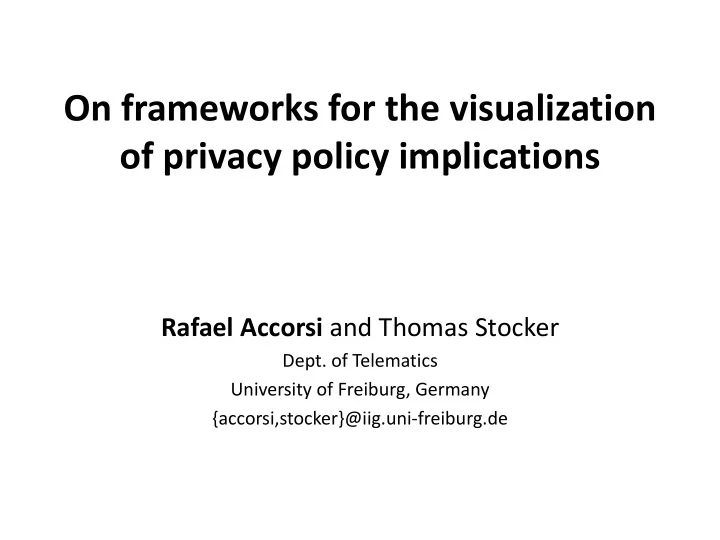

On frameworks for the visualization of privacy policy implications Rafael Accorsi and Thomas Stocker Dept. of Telematics University of Freiburg, Germany {accorsi,stocker}@iig.uni-freiburg.de
Users fail to compose strong policies • Plethora of expressive policy languages exist. – XACML, EPAL, OSL, ExPDT , … • Problems on capturing users’ intent. – Introspection and increasingly complex policies lead to “unexpected” access and usage decisions. • Need for frameworks to help users to visualize the implications of their privacy policies. accorsi@iig.uni-freiburg.de | W3C Workshop 2
Visualizing the policy difference • ExPDT: Extended Privacy Definition Tools. – Based on OWL-DL and 3-valued logic. – Authorizations with provisions and obligations. – Policy combination and comparison . • Allows the computation of policy difference. – P Sys - P User = P diff . – Visualization using data hierarchies (trees). – Complexity problems w.r.t. the difference. accorsi@iig.uni-freiburg.de | W3C Workshop 3
Policy inference in UbiComp scenarios • What (personal) data is inferred from a policy? – Environment with data fusion capabilities. – Joint work with artificial intelligence. • User controls the amount/quality of inference. – P User defines a threshold for the derivation (approximation) of a data item. – Visualization as Bayes ’ belief networks (DAGs). – Completeness problems. accorsi@iig.uni-freiburg.de | W3C Workshop 4
Policy implications in eCommerce • Which data is collected and how it is used after collection? – Definition of business process (workflows). – “Simulation” of data usage on the workflows. • User knows the traces of data usage. – Propagation graphs depict traces. – User can adjust the policy correspondingly. – Too strong assumption w.r.t. the workflows? accorsi@iig.uni-freiburg.de | W3C Workshop 5
Conclusion • Different frameworks for the visualization of privacy policy implications. • We already have expressive policy languages. – Let’s help users to get to precise policies. – Development of tools for policy management. • Not only privacy can profit from that. – Compliance engineers, auditors, etc. accorsi@iig.uni-freiburg.de | W3C Workshop 6
References • R. Accorsi et al. On the visualization of policy inferences. Submission to WISTP 2010. • M. Kaehmer et al. Automating Privacy Compliance with ExPDT. CEC/EEE 2008: 87-94. • M. Kähmer and M. Gilliot: Extended Privacy Definition Tool. PRIMIUM 2008. • S. Sackmann et al. Personalization in Privacy-Aware Highly Dynamic Systems. Comm. ACM, vol. 49(9), pp. 32-38, 2006. • S. Trudeau et al. The Effects of Introspection on Creating Privacy Policy. WPES 2009. • S. Höhn et al. An Approach to Usable Security for Ambient Intelligence Environments. Long-Term and Dynamical Aspects of Information Security, 2008. accorsi@iig.uni-freiburg.de | W3C Workshop 7
Recommend
More recommend